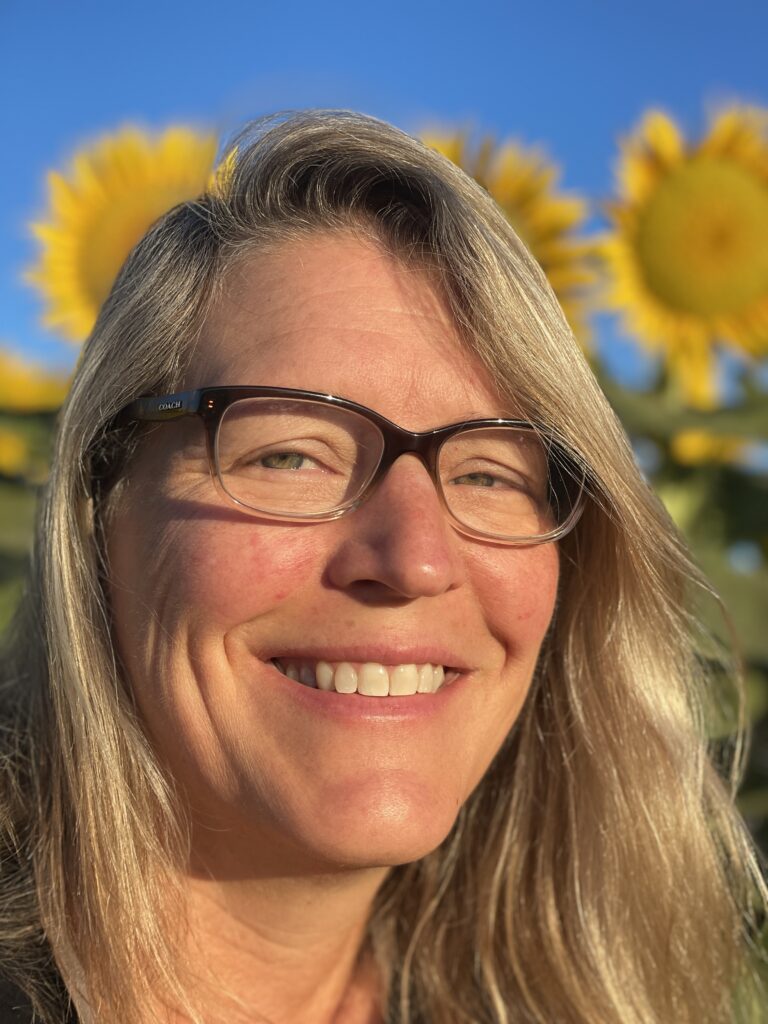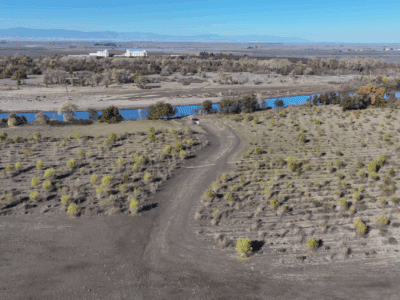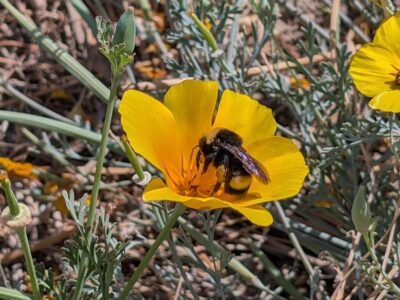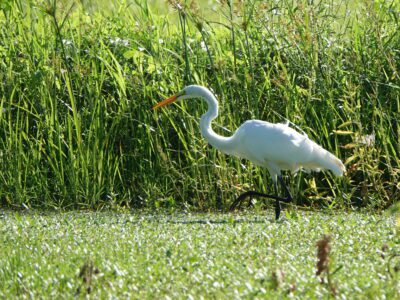
Whether she’s teaching restoration ecology classes at Santa Clara University, exploring how floodplains and natural carbon capture intersect, or taking a class in the Amazon rainforest as a research volunteer, Virginia Matzek is doing what she can to prepare future restoration ecologists.
When she returns to Santa Clara University from her year-long sabbatical for the 2025–26 academic year, it will be her 20th year teaching and her 18th year on that campus. She has co-authored nearly 30 peer-reviewed articles and taught thousands of students about ecosystem ecology and conservation. So when Matzek, one of the nation’s premier natural carbon capture scholars, says that floodplains “are hugely important” for ecosystem services, we listen.
“Floodplains punch above their weight in terms of what they do for ecosystem services, and though they’re limited to these small amounts of total acreage, that acreage is hugely critical, from wildlife corridors to flood safety to groundwater recharge and all kinds of things,” she said. “We need floodplains. We need them to be forested. We need them to be flooded periodically for a thousand reasons. The carbon picture, though—that’s complicated.”
River Partners was honored to talk with Matzek to explore the connective tissue between natural carbon capture and restored floodplains, what she would tell state leadership about natural climate solutions, and if she’s hopeful we can make meaningful environmental changes before it’s too late.
Can you explain the tradeoff between water and carbon?
The fundamental plant physiology is that in photosynthesis, when plants open the stomata in their leaves to let CO2 in for photosynthesis, water held by the leaf goes out simultaneously. If CO2 is going to come in, water has to go out—you always have to spend water to gain carbon. We’re in a dry state, so when people ask how we’re going to use our natural and working landscapes to sequester more carbon, the missing piece of that is, where will the water come from? This is one of the many reasons why I think floodplain forest restoration is such a huge component of this. They’re one of the places where it’s relatively easy to spend water to get carbon. I have to say, though, to my mind, carbon has never been the point. Carbon is the least interesting ecosystem service—and it’s what I study! It’s not the way we’re going to fix climate change, it’s not where you would get the most bang for your buck.
Why is that?
Carbon traded on the market is not that valuable, so it’s hard to incentivize people to do it. And trying to grow plants is not where you have the most leverage over the climate. But riparian corridors are so valuable that if you could get money via the carbon system to provide all of these other ecosystem services—like flood attenuation, biodiversity corridors—all of that would be worth doing. Carbon is part of a suite of valuable ecosystem services, and we focus on it because it’s the one that you can monetize most easily, but it is not the one that matters the most or that people should care most about, in my opinion.
Would the return on investment in funding riparian restoration make a big enough difference on the carbon side, even though collectively you’re getting so much more for your investment?
My paper titled, Can carbon credits fund riparian forest restoration? asks this very question: Can you pay back the public investment that’s made? And the answer is maybe. If the land is already in conservation ownership, it doesn’t have to be purchased, and you can put enough effort into third-party verification of the carbon credits to have a sense of how much carbon you have, then you can probably break even. It only pencils out in the current carbon credit system if the cost of the land is not factored in and if you’re doing the kind of large-scale, very efficient restoration River Partners is engaged in under these funding programs where you’re doing acres and acres at a time.
What are ways in which a forest could earn carbon credits?
It’s threefold. You could have a forest that you’re allowed to cut and not cut it down. That’s called avoided conversion—you get the credit for leaving the carbon intact in the trees and not selling it for timber.
Another way is improved forest management, which means you change your thinning regime, when big forest owners let their trees grow bigger and fatter and thin them differently so that more of the carbon stays on the landscape and for longer. Both avoided conversion and improved forest management are how most timber companies earn carbon credits, and that’s actively going on.
The third way is reforestation, which is what I’m most interested in, but it doesn’t pencil out well. Reforestation is too expensive compared to the price of carbon credits. The timber companies replant all the time on their own lands, but with carbon crediting, they’d have to plant and then keep those forests intact in perpetuity. It’s not planting for re-harvest later, it doesn’t meet their goals, and it doesn’t earn enough carbon credits to pay back its costs. Timberland owners aren’t really pursuing reforestation as a strategy for carbon credits, and it doesn’t really work for small landowners, either.
“Floodplains punch above their weight in terms of what they do for ecosystem services, and though they’re limited to these small amounts of total acreage, that acreage is hugely critical, from wildlife corridors to flood safety to groundwater recharge and all kinds of things…”—Virginia Matzek
Why is that? What is that a function of?
It’s because the state has very high standards for what qualifies as a carbon credit project—and for good reason. California’s carbon credits program, the Cap-and-Trade Program, is the compliance system which big utilities like PG&E and Southern California Edison have to comply with.
The way Cap-and-Trade works is that the state sets a cap on emissions and then allows the emitters to emit up to close to that cap for free. The emitters have to buy a portion of their emissions allocation at auction from the state. If the emitters can’t stay below the cap, they also have to buy credits on the open market and that’s what a carbon credit is—when an emitter goes above the cap and in order to get into compliance with the cap, they have to find carbon credits from somewhere else. Those are open market value credits. So, if the state says, “Go ahead and emit above the level that we say you can and we’ll trade it for something else,” they want to make sure that the other thing really exists and has an effect on lowering the amount of CO2 in the atmosphere.
There are many regulations around certifying carbon credits, and it’s expensive to do—it requires lawyers, a ton of paperwork, and third-party verifiers who are certified foresters. The timber companies have found that this is already part and parcel of their daily operations. They already have lawyers and this is their business. But it’s the small landholder, your farmer, your prune farmer who just wants 30 acres to go into habitat instead of prunes, who probably can’t make enough off carbon to earn back all those fees.
Then what’s the solution for the small landholder or farmer who isn’t a large company?
California has a parallel system, it works completely differently, it’s much more flexible and useful to the small landholder, and it came about sort of by accident. California designed the Cap-and-Trade system to cover the emitters who need to be in compliance with that law. And when it did, it set up the auction system I briefly mentioned earlier, where emitters have to buy a portion of their allocation from the state.
The auction proceeds were the subject of a lawsuit which said that that auction money is revenue to the state and so it’s tantamount to a tax. To settle the tax question, the state decided that all proceeds from the auction have to be used only for greenhouse gas reduction—it can’t go into the general fund or whatever. So that created this so-called Greenhouse Gas Reduction Fund, aka California Climate Investments, and the state spends it by giving it out as grants through state agencies. So as long as you can show that your project has a verifiable greenhouse gas reduction effect, you can get money from California Climate Investments.
I think it’s one of the most profound things the state is doing, because it’s not limited to natural or working lands or to things that are very high value in terms of greenhouse gas reduction—it hits all economic sectors. If you want to weatherize homes in poor neighborhoods in Humboldt County, or build bike paths in Santa Monica, or restore riparian forests in Butte County, all of those can potentially get funded through California Climate Investments Fund.
If you could have a few minutes with Governor Gavin Newsom, what would you tell him are the most important things he should know about natural climate solutions?
I might tell Gavin, the wonderful creation of Dos Rios State Park notwithstanding, is that the next frontier, I think, is private lands. If you look at oak woodlands—another ecosystem very close to my heart—about 80% of it is privately held and it’s working land. In 2001, the Oak Woodlands Conservation Act was passed to provide funding for oak woodland stewardship, and it required that every city or county have a conservation plan for oak woodland management. It was recognition that oak woodlands are really special to California, they’re biodiversity hotspots, and they require stewardship, specifically on private lands. We need more of this kind of thing everywhere, for all the habitats. The resource conservation districts are really the unsung heroes, they’re the folks doing that good work with ranchers and landholders. The RCDs are under-funded and under-resourced and I would tell Gavin, don’t think that everything you want to preserve in California needs to be behind a fence or the protection of a park. There are a lot of ranchers who want to keep running cattle and have their land remain open space. We have a lot of people who would like to continue farming more efficiently and make space for habitat. So how do we bring those people into the fold of conservation and compensate them fully for the stewardship that they do?
Another thing I might put in Gavin’s ear is the need to cut the green tape. Permitting takes way too long under programs whose intent was to safeguard the environment. It’s sort of ironic that that is sometimes the biggest hindrance to doing some of this good work.
Are you hopeful we can figure things out ecologically before we pass a tipping point?
Restoration ecology is a hopeful field. I teach in an environmental science department, and students often complain about how depressing the major is. They get a litany of problem after problem after problem, the world’s on fire, everything’s going to hell. Restoration ecology is a field where we’re working on the fixes. I always have reason to hope because I see, first of all, that when we do test restoration outcomes, things are working pretty well. I’ve found over the course of my career that nature is far more resilient than we tend to think. We’re told that it’s fragile—and sure, there are fragile aspects to it and some things are difficult to recover once they’re gone—but nature bounces back in a lot of ways too, with just a little nudge in many places. I’m hopeful that the resilience of these systems will carry us through.
What I’m pessimistic about is it happening ahead of that tipping point. I think it’s likely that we are going to go through some catastrophic change in our human societies and our ability to survive climate disasters and we’re going to have to have wholesale changes to where we live and how we live and what kinds of infrastructure we build to survive.
I don’t think life as we know it will remain the same into the long-term future, but I do think that when people work on restoration and nature conservation, we find that it is resilient and it does sustain us. I imagine the climate future will be a convulsion we’ll have to get through and then we’ll resettle at a new and different balance, and that resilience will kick in and we will also change ourselves to be more proactive at working on it. But I don’t see that happening in the five-to-10-year period I think we have before things get real.








